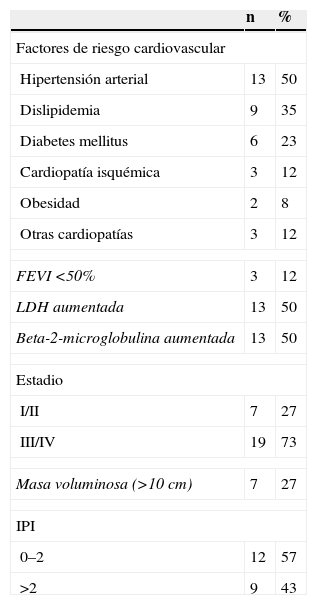La doxorrubicina liposomal no pegilada provoca menor toxicidad cardíaca que la doxorrubicina convencional, por lo que se ha empleado en pacientes de edad avanzada o con cardiopatías. El objetivo de este estudio fue valorar la eficacia y la seguridad de quimioterapias que incluyen doxorrubicina liposomal no pegilada en pacientes diagnosticados de linfoma no hodgkiniano (LNH).
Pacientes y métodoEstudio retrospectivo de pacientes con LNH tratados con doxorrubicina liposomal en 2 hospitales. Se recogieron las características demográficas, clínicas y biológicas, así como el tratamiento, la respuesta y la toxicidad.
ResultadosSe incluyeron 26 pacientes, de los que 15 (58%) eran mujeres. La mediana de edad fue de 76 años (extremos: 42–86). El tipo de LNH más frecuente fue el B difuso de célula grande (20 casos). Diecinueve pacientes (73%) se hallaban en estadio iii o iv y 12 (57%) de los 21 pacientes con linfoma B difuso de célula grande y linfoma folicular grado 3 tenían un Índice Pronóstico Internacional de alto riesgo. Tres pacientes (12%) presentaban una fracción de eyección inferior al 50% previa al tratamiento. El factor de riesgo cardiovascular más prevalente fue la hipertensión arterial (50%) y 6 pacientes (23%) presentaban antecedentes de cardiopatía. Todos recibieron doxorrubicina liposomal no pegilada como parte de la pauta R-COMP (rituximab, ciclofosfamida, vincristina, doxorrubicina liposomal y prednisona), en 20 casos (77%) tras el diagnóstico y en los 6 restantes como segunda línea. Dos pacientes fallecieron tras la administración del primer ciclo (uno por muerte súbita y otro por progresión). De los 18 pacientes tratados en primera línea, 11 (61%) pacientes alcanzaron la respuesta completa, 5 (28%) pacientes alcanzaron la respuesta parcial y 2 (11%) pacientes progresaron. De los 6 pacientes tratados tras la recaída, un paciente alcanzó la respuesta completa, 3 pacientes alcanzaron la respuesta parcial y 2 pacientes progresaron. Once pacientes (46%) presentaron neutropenia de grado iii/iv, 10 pacientes (42%) presentaron neutropenia febril y un paciente (4%) presentó trombocitopenia de grado iv. La mediana de supervivencia global fue de 50,7 meses (intervalo de confianza del 95%: 8–93,3) y la de supervivencia libre de enfermedad fue de 18,4 meses (intervalo de confianza del 95%: 18,1–18,7).
ConclusionesEn esta serie de pacientes, la mayoría de edad avanzada y con factores de riesgo cardiovascular, el tratamiento con doxorrubicina liposomal no pegilada como parte de la pauta R-COMP ha demostrado ser eficaz. La toxicidad observada fue aceptable.
Non-pegylated liposomal doxorubicin is associated with lower cardiac toxicity than conventional doxorubicin, and for that reason it has been used in the treatment of non-Hodgkin's lymphoma (NHL) in old patients or patients with cardiac disease. The objective of this study was to evaluate the efficacy and safety of chemotherapy schedules including non-pegylated liposomal doxorubicin in patients with NHL.
Patients and methodsRetrospective study of NHL patients treated with non-pegylated liposomal doxorubicin in two hospitals. In each patient demographic data, clinical and biological variables, as well as therapy, response and toxicity were recorded.
ResultsTwenty-six patients were included, 14 (58%) of them were women. Median age was 76 years (range 42–86). The most frequent histological diagnosis was diffuse large B cell lymphoma (DLBCL, 20 patients). The stage disease at diagnosis was III/IV in 19 (73%) patients whereas 12 (57%) of the 21 patients with DLBCL and grade 3 follicular lymphoma had a high-risk International Prognostic Index. Three patients had a left ventricular ejection fraction lower than 50% at the time of starting treatment. The most frequent cardiovascular risk factor was hypertension (50% of the patients) and 6 (23%) had previous heart disease. In all cases non-pegylated liposomal doxorubicin was administered as part of the R-COMP schedule (rituximab, cyclophosphamide, vincristin, non-pegylated liposomal doxorubicin and prednisone), in 20 cases (73%) as first-line treatment and in the remaining 6 as salvage therapy. Two patients died after the first cycle of chemotherapy (one because of sudden death and the other due to disease progression). Eleven (61%) out of the 18 patients receiving R-COMP as first-line therapy achieved a complete response (CR), 5 (28%) achieved partial response (PR) and 2 showed progression. Only one out of the 6 patients receiving R-COMP as salvage therapy achieved CR, whereas 3 had PR and 2 did not respond. Grade 3 or 4 neutropenia was observed in 11 (46%) patients and febrile neutropenia in 10 (42%), while only one patient developed grade 4 thrombocytopenia. The median overall survival was 50,7 months (95% confidence interval [95% CI] 8–93.3) and the median disease free survival was 18,4 months (95% CI 18.1–18.7).
ConclusionsIn this cohort of patients, most of them old and with cardiovascular risk factors, the administration of non-pegylated liposomal doxorubicin as part of R-COMP regimen was effective and safe.









